Introduction
India is the global capital of diabetes with approximately 69 million people suffering from diabetes. Pre-diabetic people are in danger of developing insulin resistant diabetes. Uncontrolled diabetes leads to many other chronic diseases like heart, liver, kidney, stroke, nervous disorders etc.[1]. The major driving force for the rapid emergence of diabetes is the consumption of energy dense food, less intake of fruits, vegetables and omega 3 fatty acids. Rice is the staple food in many countries [2]. Asia produces the 95% needs of rice globally [3]. About 60% of calorific needs of Asian people are met by rice. Some rice varieties have low concentration of readily digestible sugars and high concentration of resistant sugars. The resistant sugars are not digested by the human gastrointestinal tract. The probiotic population of intestine digests them. Rice varieties rich in resistant starch have low glycemic index (GI). GI is an indicator of the rate at which postprandial blood sugar level is increased within 90 minutes of digestion. The GI of rice varies widely from 40 to121 [4]. GI of rice is classified into low (<55), medium (55) and high (>70). Understanding the hydrolysis index (HI) and GI of rice varieties are of prime importance to prevent diabetes mellitus. Rice with higher GI values induce diabetes [5,6] and those with low GI value does not impose stress on pancreas to secrete insulin. One powerful strategy to control diabetes is to limit the release of glucose from food by inhibiting the activity of α-amylase and glucosidase [7]. One of the promising strategies to reduce the complications and counteract the metabolic alterations of diabetes is to use inhibitors of α-amylase and glucosidase. Synthetic inhibitors of amylase and glucosidase such as acarbose and miglitol induce gastrointestinal complications and hepatic injury. Side effects associated with these drugs limit their success [8]. Hence, research towards the identification of natural inhibitors becomes prime importance.
Red, purple and black rice were used since ancient time in India 9. They are good sources of resistant starch, minerals and nutraceuticals 10. Colored rice varieties available in India includes Mattai, Kiarali, Black Kavuni, Chak hao poreiton, Thavala kanna matta, Onamatta, Mapillai samba, Navara, Red Kavuni, Kuruvaikar, Poonkar, Kuzhiyadichan etc. Recently these rice varieties were evaluated for their nutraceutical properties such as antioxidants, antidiabetic etc. 11. The color and aroma of rice plays a key role in consumer preference 12. The color of the endosperm distinguishes rice into black red, brown and white 13. Different anthocyanins contribute to the color of rice. Red varieties are unique with high mineral concentration while the black varieties are rich in minerals, protein and crude fiber.
Changing the food practice based on the consumption of functional foods and foods with pharmaceutical value are complimentary approaches to mitigate diabetes and chronic diseases mapped with diabetes 14,16. Nutritional therapy aims to use foods with nutraceutical value. Nutraceuticals are products which provide nutrition and pharmaceutical value to the consumer. Many nutraceuticals play a vital role in protection against diabetes 17,18, cardiovascular diseases 19, neurological and nephrological disorders 20. They block the absorption of cholesterol and decrease the harmful effects of atherosclerosis 21. They function as potent antioxidants and anti-inflammatory agents 22. Due to increasing awareness among people about the side effects of synthetic drugs used to increase the glucose uptake in tissues 23 and the benefits of consuming functional foods, research is focused on natural compounds as therapeutic agents. The anthocyanin in rice are chemically flavonoids which serves as an antioxidant, antidiabetic, antihyperlipidemic and anti-ageing agents 24,25. Recently the correlation between disease and gut microbiome is unraveled. Establishing the probiotics in gut is essential for maintaining health.
There is only scarce scientific information on the grain properties, resistant starch and nutraceutical value of different colored varieties of rice available in India. Hence, the present study was aimed to analyze the grain characteristics, GI, resistant starch, total proteins, anti-diabetic and prebiotic activity of few colored rice varieties available in India.
Materials and Methods
Collection of Rice Varieties
Thirteen unique traditional rice varieties originated in different states of India like Tamil Nadu, Manipur and Kerala, were gifted by Spirit of earth, Chennai, Tamil Nadu, India.
Grain Dimensions
Length, Width, Thickness and Aspect ratio
Length (L) and width (W) of the rice samples were measured. Thickness (T) was measured with Vernier caliper of accuracy 0.01mm. Aspect ratio (Ra) and sphericity (Sp) of the rice were determined using the following formula,
Rα= W x100/L
Sp= (LWT) 1/3/L x 100
Based on the FAO standards, the grains are classified as long, medium and short as per the following criteria:
Long: Kernel length > 6 mm and length/width ratio 3 and above
Medium: Kernel length between 5.2 mm and 6 mm, L/W ratio < 3
Short: Kernel length <5.2 mm and L/W ratio <2
Equivalent Diameter
The equivalent diameter of the rice was calculated using the following formula followed by Haq et.al. 26.
De = (LBT) 1/3
Thousand Kernel Weight
Thousand kernels were counted and weighed in digital balance with an accuracy of 0.001g. The measurement was replicated thrice and the mean value was recorded 27.
Nutritional Properties
Estimation of Total Starch, Readily Digestible Starch and Resistant Starch
Total sugars, readily digestible sugars and resistant sugars were estimated by Glucose Oxidase- Peroxidase (GOD-POD) method.
Estimation of Total Starch
The concentration of total starch in the rice samples were estimated using porcine pancreatic amylase 28. Rice samples were powdered, sieved and homogenized with 5 mL of distilled water. To the sample, 1 mL of 100 U amylase (pancreatin) was added and incubated at 37⁰C for 15 min. The volume was made up to 25 mL with distilled water. To 1 mL of the digested sample, 10 µL of (14 U) amyloglucosidase and 2 mL of phosphate buffer (pH 4.75) were added and incubated in shaker for 60 min. It was diluted to 5 mL and the glucose was estimated using GOD-POD. The available starch was calculated using the formula,
Available Starch (%) = (µg of glucose*0.9*25)/ sample weight (mg, dry basis)
Estimation of Readily Digestible and Slowly Digestible Starch
Rice sample (1g) was homogenized with 50 mL of phosphate buffer (pH 6.9). 1 mL of 100 U amylase (Pancreatin) was added and incubated at 37⁰C in shaker. The glucose concentration was estimated at a regular interval of 30 min up to 90 min using GOD-POD 29.
Resistant Starch
The concentration of resistant starch in rice varieties was determined after complete digestion of digestible starch 19. Powdered sample (100 mg) was solubilized with 10 mL of 0.2M phosphate buffer and incubated with 1 mL of 100 U amylase (Pancreatin) for 16 h to completely hydrolyze the digestible starch. The sample was centrifuged at 10,000 rpm for 10 min and the residue was solubilized with 2.0M KOH. Glucose was estimated using GOD-POD method. The obtained value of glucose was multiplied by a factor of 0.9 to calculate the resistant starch.
Digestible Starch
The digestible starch was calculated using the following formula,
Digestible starch = Total Starch – Resistant Starch
Hydrolysis Index (HI)
HI Index was determined from the ratio of area under the hydrolysis curve (AUC) of test sample and bread as the reference sample 19. AUC was constructed using the concentration of starch hydrolyzed until 90 min as described in the readily digestible starch.
HI = (AUC of test sample/AUC of bread) *100
Glycemic Index (GI)
The GI of rice samples was calculated from the formula given by Goni et al. 29.
GI = 39.71 + 0.549*HI
Estimation of Total Proteins
The concentration of total proteins in the rice samples were estimated by Biuret method 30. 500 mg of powdered rice samples were extracted with 10 mL of NaOH at 60⁰C for 90 min. The samples were cooled to room temperature and centrifuged at 4000 g at 4°C for 30 min. To 100µL of the supernatant, 1 mL of Biuret reagent, was added and incubated at room temperature for 5 min. The optical density was recorded at 546 nm.
Nutraceutical Properties
Extraction of Anthocyanins from Rice Samples
Anthocyanin was extracted using methanol acidified with 1.5N HCl (70:30) as per the protocol of Sun et al.31. The procedure consisted of dissolving 1mg/mL of the rice powder in two different buffer solutions of hydrochloric acid-potassium chloride buffer (pH 1.5) and sodium acetate buffer (pH 4.5). The extract was dried in a rotary evaporator at 40⁰C.
Antidiabetic Activity
Antidiabetic activity of rice extract was quantified by their ability to inhibit porcine pancreatic amylase that releases reducing sugars from starch 32. 500 µL of amylase (16 U/mg) and 500µL of the anthocyanin extract of rice varieties (1mg/mL) were incubated at 25⁰C for 10 min. To the mixture, 500 µL of starch (0.05% in phosphate buffered saline of pH 6.9) was added and incubated at room temperature for 30 min. 500µL of the reaction mixture was withdrawn for the determination of reducing sugars released by amylase. A control was maintained simultaneously with enzyme and substrate without the rice extract. To the sample 1000 µL of dinitro salicylic acid was added and heated in a boiling water bath for 10 min. The tubes were cooled to room temperature and the color was read at 540 nm. Inhibition of amylase was calculated using the formula,
Inhibition of Amylase (%) = (Absorbance of control-Absorbance of sample / Absorbance of control)*100
Probiotic Activity of Anthocyanin Extracted from Rice
The prebiotic activity of anthocyanins was evaluated by viable plate count method. The probiotic organisms were purchased from Bifilac (300 million cells/100 mg powder). The bacilli were activated in MRS broth for 24 hr. The To 50 mL of MRS medium 1mL of activated probiotics (1×108 CFU/mL) and anthocyanin powder (1 mg/mL) were added and incubated for 36 hr. A tube without anthocyanin extract was used as control. The sample was diluted and plated in MRS agar plate to count the viable colonies 33.
Statistical Analysis
All experiments were replicated thrice, and the data represented are the mean of three replicates. Graphs were plotted with standard error of the mean using Graph Pad Prism 5.
Molecular Docking of Anthocyanin
Preparation of Receptor
Crystal structure of human pancreatic α-amylase (2QMK), human cytosolic β-glucosidase (2JFE) and human glucose transporter-GLUT1(4PYP), were retrieved from protein data bank. The bound ligands, cofactors and solvent molecules associated with the protein structures were removed and saved in .pdb format as an input format for PyRx and Discovery Studio Visualizing software.
Preparation of the Ligands
As the black rice variety was superior to other varieties in its resistant sugar concentration and nutraceutical properties, docking study was restricted to bioactive compounds in black rice only. The major anthocyanin pigments from black rice such as cyanidin, cyanidin-3-glucoside, cyanidin-3-rutinoside, peonidin-3-glucoside and peonidin-3-rutinoside were selected to evaluate their interaction with amylase, glucosidase and GLUT1. To compare the efficiency of anthocyanins, three clinically available drugs such as acarbose, miglitol and voglibose were used. The ligands were retrieved from PubChem database in .sdf format and then converted to .pdb format using Open Babel GUI tool. The ligands were loaded into the PyRx software.
Molecular Docking
The ligands and proteins were docked using Autodock Vina incorporated in Pyrx software and their binding affinities were obtained. The docked results were compiled, visualized and the receptor-ligand interactions were analyzed using Discovery Studio Visualizer.
Results and Discussion
Grain Dimension
There is very less scientific information about the grain dimensions of the colored rice varieties available in India. The rice varieties collected in the present study is represented in Figure 1. The figure clearly depicts the difference in the color between the rice varieties. The difference is attributed to the variation in the composition of phytochemicals. The color of the rice is due to the flavonoid group of compounds called anthocyanins, which are potent antioxidants 31, 34. The dimensions of rice grains are represented in Table 1. Physical dimensions of rice grains are critical in screening, grading and discriminating the quality. Size based classification is essential for further processing of agro products in machines 34. Length of the rice ranged from 5.1 mm to 6.3 mm. Width of the rice varieties varied between 2.5 mm and 3 mm. Lower most length (5.1 mm) and width (2.6 mm) were recorded in 60m kuruvai. Mappillai samba variety showed highest length (6.3 mm) and width (2. 9 mm). The results agree with the observations of Rui et al. 35 and Yang et al. 36. Difference in the grain size among the different varieties of rice is due to the difference in the genetic composition of the seed and soil quality. Similar results were reported in the previous studies 37. Positive correlation between the morphological parameters like area, perimeter, length, diameter width, roundness, thickness and grain weight are reported earlier 38. Grain morphology is related to milling quality. The overall appearance of rice is dependent on the uniformity in size, shape and thickness 39.
Significant variation was observed in the aspect ratio and roundedness among rice varieties. Lower roundedness indicates the cylindrical nature of rice 40. Chak hao poreiton variety has less aspect ratio of 39.68 and kothamalli samba (boiled) has the highest aspect ratio of 52.94. Wide variations in the grain dimension was reported by Correa et al.41 and Shittu et al.42. Lower roundedness indicates the cylindrical nature of rice 40. The results corroborate well with the total starch concentration presented in Figure 3. The total starch in kothamalli samba was higher than chak hao poreiton. The results clearly confirm that large grain favors dry matter accumulation than small grain relative to their hull weight. Grain dimension is useful in deciding the sieve during milling process 25. Size, shape, sphericity, aspect ratio and color are some of the grain parameters that govern the quality of rice. Grain weight increases with grain size and the duration of grain filling which in turn depend on the panicles 43.
Table 1: Grain Dimensions of Rice
| S.No | Rice Variety | Length (mm) | Width(mm) | Thickness(mm) | L/W | De(mm) | Aspect ratio (%) | Sp(%) | ||||
| 1 | Chak hao poreiton | 6.3 | 2.5 | 1.9 | 2.52 | 3.1 | 39.68 | 49.20 | ||||
| 2 | Mapillai samba (raw) | 6 | 3 | 2.1 | 2 | 3.36 | 50 | 56 | ||||
| 3 | Mapillai samba (boiled) | 6.3 | 2.9 | 1.8 | 2.17 | 3.2 | 46.03 | 50.79 | ||||
| 4 | 60m kuruvai | 5.1 | 2.6 | 1.9 | 1.96 | 2.93 | 50.9 | 57.45 | ||||
| 5 | Karuthakar poha | 5.7 | 2.8 | 1.8 | 2.03 | 3.06 | 49.12 | 53.68 | ||||
| 6 | Kothamalli samba (raw) | 5.5 | 2.7 | 2 | 2.03 | 3.09 | 49.09 | 56.18 | ||||
| 7 | Kothamalli samba (boiled) | 5.1 | 2.7 | 1.8 | 1.88 | 2.92 | 52.94 | 57.25 | ||||
| 8 | Kuzhiyadichan | 5.8 | 2.7 | 2.1 | 2.14 | 3.2 | 46.55 | 55.17 | ||||
| 9 | Navara boiled | 5.5 | 2.5 | 1.7 | 2.2 | 2.86 | 45.45 | 52 | ||||
| 10 | Perungar | 6.2 | 3 | 2 | 2.06 | 3.34 | 48.38 | 53.87 | ||||
| 11 | Kullakar (raw) | 5.3 | 2.6 | 1.7 | 2.03 | 2.86 | 49.05 | 53.96 | ||||
| 12 | Onamatta | 6.1 | 3 | 1.9 | 2.03 | 3.26 | 49.18 | 53.4 | ||||
| 13 | Thavalakannamatta | 5.5 | 2.5 | 1.6 | 2.2 | 2.8 | 45.45 | 50.90 | ||||
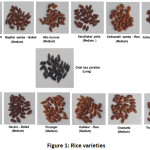 |
Figure 1: Rice varieties |
Weight of thousand kernels is represented in Figure 2. Thousand kernel weight was 18g in chak hao poreiton and 28g in perungar. Weight of grain was less in boiled variety of mappillai samba than raw variety. It is an indicator of seed quality 44 and it is due to the milling process 45. Consumer preference and pricing of rice is based on the grain dimension and quality.
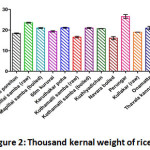 |
Figure 2: Thousand Kernal Weight of Rice |
Nutritional Profile of Rice
Total Starch
Starch in cereals is composed of repeated glucose units arranged as straight chain in amylose and branched chain in amylopectin. Total starch concentration present in the rice varieties was assessed and the results are shown in Figure 3. The concentration of total starch in rice varied from 61% (kullakar -raw) to 85 % (mapillai samba- boiled). The concentration of total starch was 78% in kothamalli samba (raw) and it was slightly higher in processed sample (81%). Similarly, a slight increase in total starch was observed in boiled variety of mapillai samba than raw variety. During processing conditions, the starch in the rice varieties were solubilized which leads to increased starch content. The present results corroborate with the reports of Omar et.al. 46 which documented the variation in starch concentration between 81-92% of total constituents. Starch from rice is different from other plant sources by their small size and the presence of hypoallergenic protein 47. The concentration of amylose in the starch determines the rate of digestion of starch. Compactness of amylose reduces its exposed surface area for digestion by salivary and pancreatic amylase 48.
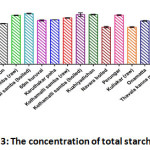 |
Figure 3: The Concentration of Total Starch in Rice |
Digestible Starch
The concentration of digestible starch present in the rice varieties are shown in Figure 4. The concentration of digestible starch in Chak hao poreiton, Kullakar (raw) and bread were 62%, 90% and 97% respectively. The digestibility of the starch varies widely due to processing conditions, genetic modification in the seeds and storage conditions. Bread is easily digestible because of the exposure of amylose and amylopectin to hydrolyzing enzymes. Many colored varieties have low digestibility because of the complex structure of amylose and amylopectin, which are not easily accessible to the enzymes. Significant portion of starch was not digestible in chak hao poreiton. The concentration of readily digestible starch increases the burst release of glucose into blood stream.
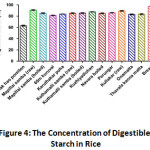 |
Figure 4: The Concentration of Digestible Starch in Rice |
Resistant Starch
Resistant starch is defined as “the fraction of starch that escapes digestion in the small intestine and that is fermented in the large intestine” 49. It is an example of complex carbohydrate that resists digestion in the stomach, and they function as soluble fiber. The concentration of resistant starch present in the rice is depicted in Figure 5. It varied widely between varieties with 38 % in chak hao poreiton and 8% in mapillai samba. The resistant starch is fermented by the microflora in the large intestine 49. Among the rice varieties used, chak hao poreiton, has the highest concentration of resistant starch, which reduces its GI 50. 60m kuruvai has second highest concentration of 19 %. Boiled mapillai samba (14%) showed high concentration than raw variety (8%). Richness of colored varieties of rice with resistant starch was supported by the observations of Deepa et.al 51. Resistant starch decrease the post prandial glucose and improves insulin sensitivity 52, 53. Rice rich in amylose content are resistant to digestion by amylase 4. Resistant starch increases the growth of beneficial bacteria in colon by supplying the free fatty acids, acetate, propionic acid and butyric acid. These short chain fatty acids increase the absorption of minerals in the bowel and prevent bowel related disorders 54.
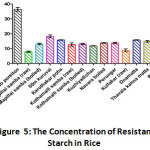 |
Figure 5: The Concentration of Resistant Starch in Rice |
Hydrolysis Index
Hydrolysis of starch determines the body’s response to metabolic conditions such as hyperglycemia and hyperlipidemia55. The hydrolysis of starch at different time intervals is represented in Figure 6. Starch hydrolysis was very rapid in bread where more than 90% of starch was hydrolyzed within 90 min. In chak hao poreiton only 20% of starch was hydrolyzed in 90 min. Kothamalli samba variety rapidly digested 90% of starch within 90 min. Other varieties of rice were intermediate between bread and Chak hao poreiton. The Hydrolysis Index of the food sample is calculated from the starch hydrolysis curve with bread as the reference food and the results are shown in Figure 7. The HI of bread was 10056. Karuthakar poha and chak hao poreiton have low HI of 22 and 25 respectively. This low HI may be due to the fact that the rice samples may contain non-starch polysaccharides 56, 57. Boiled mapillai samba has lower hydrolysis index than raw variety. The results are in accordance with the observations of Perera 58. Variation in the hydrolysis of starch among the different sources of plant and within the varieties were supported by the observations of starch digestibility both among plant sources and within a single variety 59, 60.
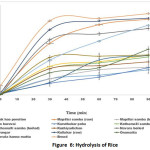 |
Figure 6: Hydrolysis of Starch |
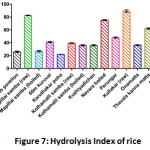 |
Figure 7: Hydrolysis Index of Rice |
Glycemic Index
GI determines the rate at which the body converts starch into a reducing sugar. It is directly proportional to HI value. The GI values of rice varieties are presented in Figure 8. GI of rice varieties varied significantly between 83 and 52. Higher glycemic index of bread is attributed to the solubility of starch and its susceptibility to amylase action which releases glucose rapidly. Studies by Miller et.al. 4 reported the wide variation in GI value of rice from 62 to 93. Raw Mapillai samba has the highest GI (83) compared to boiled variety (52). Still higher GI of 102 was reported by Frei et al. 59. Karuthakar Poha and chak hao poreiton have low GI of 52 and 53 respectively. The observed variation in the GI among the rice varieties is due to the difference in the composition of starch, particle size, the concentration of other nutrients such as lipids, fiber and proteins 13.Varieties like mapillai samba and kullakar rice with higher GI values release high concentration of glucose 60. Therefore, it leads to hyper insulinemia and culminates insulin receptor down regulation 61. Moreover, foods with higher glycemic index triggers hunger rapidly and induce over eating and obesity 62. American Diabetes Association describes the significance of controlling blood sugar to prevent the worst consequence of diabetes mellitus 31,63.Rice with low GI value is preferred recently due to increased awareness about the relationship between the GI and diabetes. Low glycemic index diets enhance insulin sensitivity and improve metabolic and cardiovascular risk factors. Foods with low glycemic index protect people from obesity, type II diabetes 64-66, breast cancer, gall bladder disease 67 and cardiovascular disease 68, 69. Low glycemic food reduces the absorption of glucose and imposes no stress to pancreas to secrete insulin, gastric inhibitory peptide and glucagon like peptide. Low GI food reduces obesity and diseases linked with obesity 70.
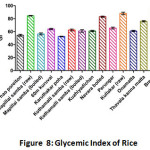 |
Figure 8: Glycemic Index of Rice |
Total Proteins
The total proteins present in the rice varieties is shown in Figure 9. Rice is an important source of protein. The protein concentration of almost all the rice samples is less than 20%. High concentration of protein (16%) was observed in chak hao poreiton followed by mapillai samba raw (11%). The results agree with the previous records 71. Rice varieties with high concentration of proteins decrease the access of enzyme for starch hydrolysis 71. As the concentration of protein was high in Chak hao poreiton, the hydrolysis index and GI are also low in the same variety.
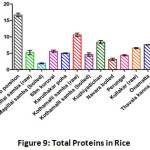 |
Figure 9: Total Proteins in Rice |
Antidiabetic Activity of Anthocyanin
Inhibition of amylase by anthocyanins is evident from Figure10. Inhibition of amylase by anthocyanin of chak hao poreiton was highest with 24% followed by kothamalli samba (14%). Lower most inhibition of 4% was exhibited by mapillai samba variety. The results are similar to the observation of Stephenet al. 72. The significant difference in the amylase activity was correlated to the difference in the concentration of anthocyanins in the rice varieties. Anthocyanins from different food sources were reported to possess inhibition towards amylase and glucosidase 73,75. Inhibition of amylase activity reduces the release of sugars into the blood thus reducing the burden of diabetes 73. Anthocyanins compete for the catalytic sites of amylase and glucosidase by mimicking the structure of starch 76. Anthocyanin glucosides mimic the transition state complex of enzyme substrate complex and block the enzyme activity. Other studies supported that the bulky structure of anthocyanin masks the active site like a cap and prevent the binding of carbohydrates to the hydrolyzing enzyme 77. Few other studies described the inhibition of amylase and glucosidase by noncompetitive and mixed inhibition 78.81. Anthocyanins exhibit antidiabetic activity, not only by inhibiting the hydrolytic enzymes but also inhibiting the glucose transporters that are essential for the transport of glucose. So, anthocyanins are potent in regulating the glucose level by multiple ways 81. Hence, the traditional colored varieties of rice are nutritionally and pharmaceutically significant.
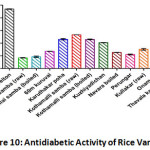 |
Figure 10: Antidiabetic Activity of Rice Varieties |
Prebiotic Activity of Anthocyanin
Gut microbiome plays a vital role in the health and diseased status of human being. The biological effect of any active ingredient of food or pharmaceutical formulation depends on the colonic microbiome. Hence in the present study, the effect of anthocyanin in maintaining the gut microbiome was assessed and the results are presented in Figure 11. The number of viable probiotic bacteria increased significantly in the medium supplemented with anthocyanin. In control without anthocyanin, the number of colonies was log 0.15CFU/mL. It was significantly increased to log 1.95 CFU/mL in Chak hao poreiton. Growth promoting effect of anthocyanin was supported by the observations of Sun et.al 31 and Díaz-Rizzoloet.al 82. The anthocyanin in Chak hao poreiton is primarily glycosylated derivatives. These glycosyl units are hydrolyzed by glucosidases synthesized by probiotics. The released glucose is used for the growth of probiotics83. The growth promoting activity of Karuthakar poha increase the bacterial count to log 1.0 CFU/mL. Growth inducing effect of anthocyanin on Bifidobacterium bifidum, Bifidobacterium adolescentis, Bifidobacterium infantis and Lactobacillus acidophilus were supported in previous studies.
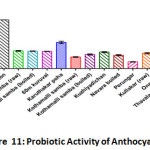 |
Figure 11: Prebiotic Activity of Anthocyanins |
Firmicutes/bacteroidetes which are abundant in the gut of hyperlipedemic and obese human were reversed by the supplementation of anthocyanin extract from black rice. Supplementation of anthocyanin increased the bacteria from phylum such as Lactobacillus, Bifidobacterium, Parabacteroides, Oscillospira, Akkermansia, Ruminococcus, and Butyricimonas and simultaneously decreased Clostridium and Desulfovibrio 84,87.
Molecular Docking of Anthocyanin
The interaction of major anthocyanins of black colored rice with pancreatic α-amylase, β-glucosidase and GLUT1 was analyzed by molecular docking. The results were compared with clinically available drugs such as acarbose, miglitol and voglibose. The free energy of binding of the ligands and controls with the target proteins are shown in Table 2. The table reveals the strong affinity between the anthocyanins and proteins than the control drugs. Drug ability analysis of cyanidin-3-glucoside, cyanidin-3-rutinoside, peonidin-3-glucoside and peonidin-3-rutinoside showed more than 2 violations in Lipinski rule. Cyanidin has good drug likeliness with the binding affinity ofc-7.9 kcal/mol, -4.3kcal/mol and -8.5kcal/mol against amylase, glucosidase and GLUT 1 respectively.The binding affinity of cyanidin was greater than acarbose and miglitol against α- amylase and β- glucosidase. Affinity to GLUT1 was equal to voglibose.
Table 2: Binding affinity of anthocyanins to carbohydrate regulating enzymes and glucose transporter
| Ligand | Binding affinity (kcal/mol) | ||
| Amylase | Glucosidase | GLUT 1 | |
| Acarbose | – 7.5 | – 3.0 | – 8.9 |
| Miglitol | – 5.7 | – 3.5 | – 5.8 |
| Voglibose | – 8.1 | – 3.8 | – 8.5 |
| Cyanidin | – 7.9 | – 4.3 | – 8.5 |
| Cyanidin-3-glucoside | – 9.9 | -10.0 | -10.4 |
| Cyanidin-3-rutinoside | -10.8 | -10.8 | -10.9 |
| Peonidin-3-glucoside | – 6.8 | – 3.6 | – 9.3 |
| Peonidin-3-rutinoside | – 6.8 | -10.0 | – 9.6 |
Based on the results of drug likeliness, only cyanidine was used for further analysis.Interaction of acarbose, miglitol, voglibose and cyanidin with amylase, glucosidase and GLUT 1 are shown in Figure 12,13, and 14 respectively. Voglibose binds with Asp197, Glu 300 and Asp 233 which are the active site residues of pancreatic α- amylase 88. Similarly, cyanidin also binds with Glu 233 and Asp 300 confirming the competitive inhibition. The binding of cyanidin with the active site residues are supported by the observations of Xu et.al. 89. Acarbose and miglitol binds with α-amylase in many sites other than the active sites. Oudjeriouat, et.al. 90 reported the uncompetitive inhibition of barely α-amylase by acarbose.
Active site of glucosidase is comprised of Glu 165, Glu 273 and Gln 307. Hydrophobic amino acids such as Phe179, Phe121, Phe 225, Phe 433, Tyr 308, Tyr 309, Trp 345 and Trp 425 covers the substrate 91. Active site binding was not observed in controls and cyanidin confirming the absence of competitive inhibition. Cyanidin binds with glucosidase through vanderwaals forces and hydrogen bond. Strongest affinity of cyanidin to glucosidase than acarbose corroborates with the results of Chen et.al. 92. GLUT1 mobilizes glucose to tissues and reduces the concentration of postprandial glucose. Hence, in the present study, the binding of cyanidin with GLUT1 was evaluated. Control drugs and cyaniding revealed similar bindig sites as represented in Figure 14.Trp 388 and Trp 412 are absolutely essential for transport of glucose through GLUT1. Acarbose and cyanidine interact with both residues.Trp 388 was bound by all controls and cyanidin. Similar interaction was documented by Son and Lee.93. In addition to the essential sites, the interaction involved many residues which contributed to higher binding affinity. The results confirm the interaction of cyanidin with α-amylase, β-glucosidase and glucose transporter to reduce the postprandial glucose level.
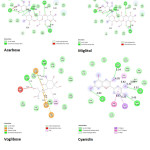 |
Figure 12: 2D Interaction View of the Ligands Against Pancreatic α-amylase |
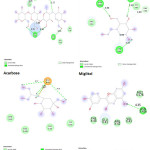 |
Figure 13: 2D Interaction View of the Ligands Against β-glucosidase |
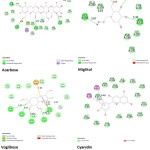 |
Figure 14: 2D Interaction View of the Ligands Against GLUT 1 |
Conclusion
Among the rice varieties used, chak hao poreiton has low concentration of total starch, high concentration of resistant starch, lowermost, GI and high concentration of proteins. The variety is the richest source of anthocyanins that possess antidiabetic and probiotic activity. Molecular docking revealed the binding of cyanidin from Chak hao poreiton with pancreatic α-amylase, β-glucosidase and GLUT 1 with key residues essential for their function.
Acknowledgement
The authors thank “Spirit of Earth”, Chennai, Tamil Nadu, and India for providing the unique rice varieties. The authors thank Ms. Gazana Iraivan, M.Tech, Department of Biotechnology, Mepco Schlenk Engineering College for molecular docking analysis. The authors thank the Head of the department, Principal and Management board, Mepco Schlenk Engineering College (Autonomous), Sivakasi, Tamil Nadu, India for all support.
Conflict of Interest
The authors have no conflicts of interest
Funding Source
Not applicable
Author’s Contributions
Mala Rajendran conceived the concept and designed the experimental plan and Keerthana Ravi Chandran executed the experiments.
Reference
- Zimmet P, Alberti KG, Shaw J. Global and societal implications of the diabetes epidemic. Nature 2001;414(6865):782-7.
CrossRef - Beinner, Mark Anthony, Soares, Anne Danieli Nascimento, Barros, Ana Laura Antunes, & Monteiro, Marlene Azevedo Magalhães. Sensory evaluation of rice fortified with iron. Food Science and Technology 2010;30(2): 516-519.
CrossRef - Rathna PriyaTS, Eliazer Nelson ARL, Ravichandran K, AntonyU. Nutritional and functional properties of coloured rice varieties of South India: a review. Journal of Ethnic Foods 2019;6(11).
CrossRef - Miller JB, Pang E, Bramall L. Rice: a high or low glycemic index food? American Journal of Clinical Nutrition. 1992;56(6):1034-6.
CrossRef - Siti Dewi Indrasaria, EY. Purwanib, Wibowoa P, Jumalia. Glycemic indices of some rice varieties. Indonesian Journal of Agricultural Science 2010;3(1):9-16.
- Hu EA, Pan A, Malik V, Sun Q. White rice consumption and risk of type 2 diabetes: meta-analysis and systematic review. BMJ. 2012;344:e1454.
CrossRef - Asgar MA. Anti-Diabetic Potential of Phenolic Compounds: A Review. International Journal of Food Properties. 2011:91-103.
CrossRef - Perfetti R, Barnett P, Mathur R, Egan J. Novel therapeutic strategies for the treatment of Type 2 diabetes. Diabetes / Metabolism Reviews. 1998;14(3):207-225.
CrossRef - AhujaU, Ahuja SC, Chudhry N, Thakkar, R. Red Rices – Past, Present, and Future. Asian Agricultural History. 2007;11(4): 1-10.
- Oki T, Masuda M, Nagai S, Take’ichi M, Kobayashi, M, Nishiba, Y, Sugawara T, Suda, I, Sato, T. Radical-scavenging activity of red and black rice. In: Rice is Life: Scientific Perspectives for the 21st Century. Proceedings of the World Rice Research Conference, , Tokyo and Tsukuba, Japan (Toriyama, K., Heong, K.L., and Hardy, B., eds.). International Rice Research Institute, Los Baños, Philippines; and Japan International Research Center for Agricultural Sciences, Tsukuba, Japan. 2004; 256–259.
- Deng GF, Xu XR, Zhang Y, Li D, Gan RY, Li HB. Phenolic compounds and bioactivities of pigmented rice. Critical Reviews in Food Science and Nutrition 2013;53(3):296-306.
CrossRef - Meullene JF, Griffin TVK, Carson K, Davis G, Davis S, Gross J Hankins JA, SailerE,SitakalinC,SuwansriS,Vasquezcaicedo AL. Rice external preference mapping for asian consumers living in the united states. Journal of Sensory Studies 1999;16:73-64.
CrossRef - Finocchiaro F, Ferrari B, Gianinetti A, Dall’asta C, Galaverna G, Scazzina F, Pellegrini N. Characterization of antioxidant compounds of red and white rice and changes in total antioxidant capacity during processing. Molecular Nutrition and Food Research 2007;51(8):1006-19.
CrossRef - Venkatakrishnan K, Chiu H, Wang C. Popular functional foods and herbs for the management of type-2-diabetes mellitus: A comprehensive review with special reference to clinical trials and its proposed mechanism. Journal of Functional Foods. 2019;57:425-438.
CrossRef - Alkhatib A, Tsang C, Tiss A, Bahorun T, Arefanian H, Barake R et al. Functional Foods and Lifestyle Approaches for Diabetes Prevention and Management. Nutrients. 2017;9(12):1310.
CrossRef - Guasch-Ferré M, Merino J, Sun Q, Fitó M, Salas-Salvadó J. Dietary Polyphenols, Mediterranean Diet, Prediabetes, and Type 2 Diabetes: A Narrative Review of the Evidence. Oxidative Medicine and Cellular Longevity. 2017;2017:1-16.
CrossRef - Kalra E. Nutraceutical-definition and introduction. AAPS PharmSci. 2003;5(3):27-28.
CrossRef - Nasri H, Baradaran A, Shirzad H, Rafieian-Kopaei M. New concepts in nutraceuticals as alternative for pharmaceuticals. International Journal of Preventive Medicine. 2014 ;5(12):1487-99.
- Khosravi-Boroujeni H, Sarrafzadegan N, Mohammadifard N, Sajjadi F, Maghroun M, Asgari S, et al. White rice consumption and CVD risk factors among Iranian population. Journal of Health, Population and Nutrition. 2013;31:252–61.
CrossRef - Roohafza H, Sarrafzadegan N, Sadeghi M, Rafieian-Kopaei M, Sajjadi F, Khosravi-Boroujeni H. The association between stress levels and food consumption among Iranian population. Archives of Iranian Medicine. 2013;16:145–8.
- Setorki M, Rafieian-Kopaei M, Merikhi A, Heidarian E, Shahinfard N, Ansari R, et al. Suppressive impact of anethumgraveolens consumption on biochemical risk factors of atherosclerosis in hypercholesterolemic rabbits. International Journal of Preventive Medicine. 2013;4:889–95.
- Ghayur MN, Gilani AH, Afridi MB, Houghton PJ. Cardiovascular effects of ginger aqueous extract and its phenolic constituents are mediated through multiple pathways. Vascular Pharmacology. 2005;43:234–4.
CrossRef - Consoli A, Formoso G. Do thiazolidinediones still have a role in treatment of type 2 diabetes mellitus? Diabetes, Obesity and Metabolism2013;15(11):967-77.
CrossRef - Extraction of anthocyanogens from black rice. Application CN 200510049274 (2005).
- Sung Hyun Kim, Jung Ae Ju.. Black Rice Sprouting Liquid Having Anti-Inflammatory Effect And Manufacturing Method Thereof. Patents 16/359572 2019.
- Haq R, Wani M Prasad K. Engineering properties of high and low altitude rice varieties from Kashmir valley at different processing levels. Cogent Food And Agriculture 2016; 2: 1133371.
CrossRef - Varnamkhasti MG, Mobli H, Jafari A, Keyhani AR. Some physical properties of rough rice (Oryza Sativa L.) grain. Journal of Cereal Science 2008;47(3):496-501.
CrossRef - Giri S, Banerji A, Lele, SS, Ananthanarayan L. Starch digestibility and glycaemic index of selected Indian traditional foods: Effects of added ingredients. International Journal of Food Properties 2017;20. sup1, S290-S305.
CrossRef - Goñi I, Garcia-Alonso A, Saura-Calixto FA starch hydrolysis procedure to estimate glycemic index. Nutrition Research 1997;17(3):427-37.
CrossRef - Gornall AG., Bardawill, CS. David MM. Determination of serum proteins by means of the biuret reaction, Journal of Biological Chemistry 1949; 177: 751.
- Sun H, Zhang P, Zhu Y, Lou Q, He S. Antioxidant and prebiotic activity of five peonidin-based anthocyanins extracted from purple sweet potato (Ipomoea batatas (L.) Lam.). Scientific Reports 2018;8(1):5018.
CrossRef - Apostolidis E, Kwon Y, Shetty K. Inhibitory potential of herb, fruit, and fungal-enriched cheese against key enzymes linked to type 2 diabetes and hypertension. Innovative Food Science & Emerging Technologies. 2007;8(1):46-54.
CrossRef - Yang E, Fan L, Yan J, Jiang Y, Doucette C, Fillmore S et al. Influence of culture media, pH and temperature on growth and bacteriocin production of bacteriocinogenic lactic acid bacteria. AMB Express. 2018;8(1).
CrossRef - Moreda GP, Ortiz-Cañavate J, García-Ramos FJ, Ruiz-Altisent M. Non-destructive technologies for fruit and vegetable size determination – A review. Journal of Food Engineering 2009;92(2):119-36.
CrossRef - Rui CQ, Zhao AC. Genetic analysis of weight and shape of F1’s grains by diallel crossing method for indica rice. Sci Agric Sin 1983;5:14-20.
- Yang LS, Bai YS, Chen DP, Yang JB, Ding CC. Correlation analysis of grain characters for japonica hybrid rice. Journal of Anhui Agricultural Sciences 2002;30(3):321-3.
- Smanalievaa J, Salievaa K, Bakyt, Borkoeva, J.Windhabb E, Fischer P. Investigation of changes in chemical composition and rheological properties of Kyrgyz rice cultivars (Ozgon rice) depending on long-term stack-storage after harvesting. LWT – Food Science and Technology 2015;63(1):626-32.
CrossRef - Xie L, Tang S, Chen N, Luo J, Jiao G, Shao G, . Rice Grain Morphological Characteristics Correlate with Grain Weight and Milling Quality. Cereal chemistry. 2013.90(6) 587-593.
CrossRef - Ikehashi H, Kush GS, Methodology of assessing appearance of the rice grain, including chalkiness and whiteness In: International Rice Research Institute: Los Banos, Philippines, International Rice Research Institute.1979;223-230.
- OomobuwajoaT,.Sanni L.Olajide J. Physical properties of ackee apple (Blighia sapida) seeds. Journal of Food Engineering 2000;45(1):43-8.
CrossRef - Correa PC, deSilva FS, Jaren C, Afasa Junior PC, Arana I. Physical and mechanical properties in rice processing. Journal of Food Engineering 2007;79(1):137-42.
CrossRef - Shittu TA, Olaniyi MB, Oyekanmi AA, Okeleye KA. Physical and water absorption characteristics of some improved rice varieties. Food and Bioprocess Technology 2012;5(1):298-309.
CrossRef - Sasahara T, Takahashi M, Kambayashi M. Studies on structure and function of the rice ear. III. Final ear weight, and increasing rate of ear weight and decreasing rate of straw weight at the maximum increasing period of ear weight. Japenese journal of crop science 1982;51(1):18-25.
CrossRef - Hossein Afshari, Mostafa Eftekhari, Miad Faraji, Ebadi A. Studying the effect of 1000 grain weight on the sprouting of different species of Salvia L. grown in Iran. Journal of medicinal plant research 2011;5(16). p. 3991-3993.
- Ozguven F, Kubilay V. Some physical, mechanical and aerodynamic properties of pine (Pinus pinea) nuts. Journal of Food Engineering 2004;68(2):191-6.
CrossRef - OmarKA, Salih BM, AbdullaNY, Hussin BH., Rassul SM. Evaluation of Starch and Sugar Content of Different Rice Samples and Study their Physical Properties. Indian Journal Of Natural Sciences 2016; 6 (36), 11084 – 11093.
- Schoch TJ.Properties and uses of rice starch, In Whister, R. L. and Paschall, E. F. (Eds.), Starch Chemistry and Technology, 1967;79–86.
- Frost G, Dornhorst A. The relevance of the glycaemic index to our understanding of dietary carbohydrates. Diabetic Medicine. 2000;17(5):336-345.
CrossRef - Maier TV, Lucio M, Lee LH, VerBerkmoes NC, Brislawn CJ, Bernhardt J, Lamendella R, McDermott JE, Bergeron N, Heinzmann SS, Morton JT, González A, Ackermann G, Knight R, Riedel K, Krauss RM, Schmitt-Kopplin P, Jansson JK. Impact of Dietary Resistant Starch on the Human Gut Microbiome, Metaproteome, and Metabolome. MBio. 2017;8(5).
CrossRef - Champ M, Langkilde AM, Brouns F, Kettlitz B & Le Bail-Collet Y. Advances in dietary fibrecharacterisation II. Consumption, chemistry, physiology and measurement of resistant starch: implications for health and food labelling. Nutrition Research Reviews 2003; 16, 143–161.
CrossRef - Deepa G, Singh V, Naidu K. A comparative study on starch digestibility, glycemic index and resistant starch of pigmented (‘Njavara’ and ‘Jyothi’) and a non-pigmented (‘IR 64’) rice varieties. Journal of Food Science and Technology. 2010;47(6):644-649.
CrossRef - Choi Y, Giovannucci E, Lee J. Glycaemic index and glycaemic load in relation to risk of diabetes-related cancers: a meta-analysis. British Journal of Nutrition. 2012;108(11):1934-1947.
CrossRef - Amin T, Naik H, Hussain S, Mir M, Jabeen A. In vitro digestion, physicochemical and morphological properties of low glycemic index rice flour prepared through enzymatic hydrolysis. International Journal of Food Properties. 2018;21(1):2632-2645.
CrossRef - Bird A, Conlon M, Christophersen C, Topping D. Resistant starch, large bowel fermentation and a broader perspective of prebiotics and probiotics. Beneficial Microbes. 2010;1(4):423-431.
CrossRef - ArayaM, Morelli L, Reid G, Sanders ME, StantonC, PineiroM, BenEmbarkP. Guidelines for the evaluation of probiotics in food. Joint FAO/WHO Work.Gr.Rep.Draft.Guidel. Eval. Probiotics food. 2002;1-11.
- Granfeldt Y, Bjorck I, Drews A, Tovar J. An in vitro procedure based on chewing to predict metabolic response to starch in cereal and legume products. Eur J Clin Nutr. 1992;46(9):649-60.
- David Barine KK, Yorte GS. In Vitro Starch Hydrolysis and Prediction of Glycemic Index (PGI) in “Amala” and Plantain Based Baked Products. . Journal of Food Research 2016;5:73-80.
CrossRef - Perera AS, Jansz ER. Preliminary investigations on the red pigment in rice and its effect on glucose release from rice starch. Journal of the National Science Foundation of Sri Lanka. 2011;28(3):185-192.
CrossRef - Frei M, Siddhuraju P,.Becker K. Studies on the in vitro starch digestibility and the glycemic index of six different indigenous rice cultivars from the Philippines. Food Chemistry 2003;83(3):395-402.
CrossRef - Hu P, Zhao H, Duan Z, Linlin Z, Wu D. Starch digestibility and the estimated glycemic score of different types of rice differing in amylose contents. Journal of Cereal Science. 2004;40(3):231-237.
CrossRef - Esfahani A, Wong J, Mirrahimi A, Srichaikul K, Jenkins D, Kendall C. The Glycemic Index: Physiological Significance. Journal of the American College of Nutrition. 2009;28(sup4):439S-445S.
CrossRef - Ludwig DS: The glycemic index: physiological mechanisms relating to obesity, diabetes, and cardiovascular disease. JAMA 2002; 287:2414–2423.
CrossRef - Sheard N, Clark N, Brand-Miller J, Franz M, Pi-Sunyer F, Mayer-Davis E et al. Dietary Carbohydrate (Amount and Type) in the Prevention and Management of Diabetes: A statement by the American Diabetes Association. Diabetes Care. 2004;27(9):2266-2271.
CrossRef - Salmeron J, Ascherio A, Rimm E, Colditz G, Spiegelman D, Jenkins D et al. Dietary Fiber, Glycemic Load, and Risk of NIDDM in Men. Diabetes Care. 1997;20(4):545-550.
CrossRef - Zhang C, Liu S, Solomon C, Hu F. Dietary Fiber Intake, Dietary Glycemic Load, and the Risk for Gestational Diabetes Mellitus. Diabetes Care. 2006;29(10):2223-2230.
CrossRef - Thomas D, Elliott E. Low glycaemic index, or low glycaemic load, diets for diabetes mellitus. Cochrane Database of Systematic Reviews. 2009;1
CrossRef - Barclay A, Petocz P, McMillan-Price J, Flood V, Prvan T, Mitchell P et al. Glycemic index, glycemic load, and chronic disease risk—a meta-analysis of observational studies. The American Journal of Clinical Nutrition. 2008;87(3):627-637.
CrossRef - Liu S, Willett W, Stampfer M, Hu F, Franz M, Sampson L et al. A prospective study of dietary glycemic load, carbohydrate intake, and risk of coronary heart disease in US women. The American Journal of Clinical Nutrition. 2000;71(6):1455-1461.
CrossRef - Oh K. Carbohydrate Intake, Glycemic Index, Glycemic Load, and Dietary Fiber in Relation to Risk of Stroke in Women. American Journal of Epidemiology. 2005;161(2):161-169.
CrossRef - Livesey G, Taylor R, Hulshof T, Howlett J. Glycemic response and health—a systematic review and meta-analysis: relations between dietary glycemic properties and health outcomes. The American Journal of Clinical Nutrition. 2008;87(1):258S-268S.
CrossRef - Jenkins DJ, Wolever TM, Collier GR, Ocana A, Rao AV, Buckley G, et al. Metabolic effects of a low-glycemic-index diet. The American Journal of Clinical Nutrition. 1987;46(6):968-75.
CrossRef - Stephen M. Boue, Kim W. Daigle, Ming-Hsuan Chen, Heping Cao, Heiman ML. Antidiabetic Potential of Purple and Red Rice (Oryza sativa L.) Bran Extracts. Journal of Agricultural and Food Chemistry. 2016;64(24):5345−53.
CrossRef - Gowd V, Jia Z, Chen W. Anthocyanins as promising molecules and dietary bioactive components against diabetes – A review of recent advances. Trends in Food Science & Technology. 2017;68:1-13.
CrossRef - Castro-Acosta M, Lenihan-Geels G, Corpe C, Hall W. Berries and anthocyanins: promising functional food ingredients with postprandial glycaemia-lowering effects. Proceedings of the Nutrition Society. 2016;75(3):342-355.
CrossRef - Zhang J, Sun L, Dong Y, Fang Z, Nisar T, Zhao T et al. Chemical compositions and α-glucosidase inhibitory effects of anthocyanidins from blueberry, blackcurrant and blue honeysuckle fruits. Food Chemistry. 2019;299:125102.
CrossRef - Cerqueira N, Bras N, Fernandes PA, Ramos M.J. Glycosidases—A Mechanistic Overview. IntechOpen: London, UK, 2012.
CrossRef - Wiese S, Gärtner S, Rawel H, Winterhalter P, Kulling S. Protein interactions with cyanidin-3-glucoside and its influence on α-amylase activity. Journal of the Science of Food and Agriculture. 2009;89(1):33-40.
CrossRef - López-Angulo G, Montes-Avila J, Sánchez-Ximello L, Díaz-Camacho S, Miranda-Soto V, López-Valenzuela J et al. Anthocyanins of Pithecellobium dulce (Roxb.) Benth. Fruit Associated with High Antioxidant and α-Glucosidase Inhibitory Activities. Plant Foods for Human Nutrition. 2018;73(4):308-313.
CrossRef - Homoki J, Nemes A, Fazekas E, Gyémánt G, Balogh P, Gál F et al. Anthocyanin composition, antioxidant efficiency, and α-amylase inhibitor activity of different Hungarian sour cherry varieties (Prunus cerasus). Food Chemistry. 2016;194:222-229.
CrossRef - Kalita D, Holm D, LaBarbera D, Petrash J, Jayanty S. Inhibition of α-glucosidase, α-amylase, and aldose reductase by potato polyphenolic compounds. PLOS ONE. 2018;13(1):e0191025.
CrossRef - Oliveira H, Fernandes I, Brás N, Faria A, De Freitas V, Calhau C et al. Experimental and Theoretical Data on the Mechanism by Which Red Wine Anthocyanins Are Transported through a Human MKN-28 Gastric Cell Model. Journal of Agricultural and Food Chemistry. 2015;63(35):7685-7692.
CrossRef - Díaz-Rizzolo D, Kostov B, López-Siles M, Serra A, Colungo C, González-de-Paz L et al. Healthy dietary pattern and their corresponding gut microbiota profile are linked to a lower risk of type 2 diabetes, independent of the presence of obesity. Clinical Nutrition. 2020;39(2):524-532.
CrossRef - Flores G, Ruiz del Castillo M, Costabile A, Klee A, Bigetti Guergoletto K, Gibson G. In vitro fermentation of anthocyanins encapsulated with cyclodextrins: Release, metabolism and influence on gut microbiota growth. Journal of Functional Foods. 2015;16:50-57.
CrossRef - Faria A, Fernandes I, Norberto S, Mateus N, Calhau C. Interplay between Anthocyanins and Gut Microbiota. Journal of Agricultural and Food Chemistry. 2014;62(29):6898-6902.
CrossRef - Hester S, Mastaloudis A, Gray R, Antony J, Evans M, Wood S. Efficacy of an Anthocyanin and Prebiotic Blend on Intestinal Environment in Obese Male and Female Subjects. Journal of Nutrition and Metabolism. 2018;2018:1-11.
CrossRef - Zhu Y, Sun H, He S, Lou Q, Yu M, Tang M et al. Metabolism and prebiotics activity of anthocyanins from black rice (Oryza sativa L.) in vitro. PLOS ONE. 2018;13(4):e0195754.
CrossRef - Wang H, Liu D, Ji Y, Liu Y, Xu L, Guo Y. Dietary Supplementation of Black Rice Anthocyanin Extract Regulates Cholesterol Metabolism and Improves Gut Microbiota Dysbiosis in C57BL/6J Mice Fed a High‐Fat and Cholesterol Diet. Molecular Nutrition & Food Research. 2020;64(8):1900876.
CrossRef - Brayer GD, Luo Y, Stephen G. Withers V. The structure of human pancreatic a-amylase at 1.8 A resolution and comparisons with related enzymes.Protein Science. 1995; 4:1730-1742.
CrossRef - Sui X, Zhang Y, Zhou W.In vitro and in silico studies of the inhibition activity of nthocyanins against porcine pancreatic α-amylase. Journal of Functional Foods.2016;21:50–57.
CrossRef - Oudjeriouat N, Moreau Y, Santimone M, Svensson B, Marchis-Mouren G, Desseaux V. On the mechanism of α-amylase. Acarbose and cyclodextrin inhibition of barley amylase isozymes. 2003;270(19):3871–3879.
CrossRef - Berrin JG, Czjzek M, Kroon PA, McLauchlan WR, Puigserver A, Williamson G, Juge N. Substrate (aglycone) specificity of human cytosolic beta-glucosidase. Biochemical Journal. 2003 1;373(Pt 1):41-48.
CrossRef - Chen J, Wu S, Zhang Q, Yin Z, Lu Z. α-Glucosidase inhibitory effect of anthocyanins from Cinnamomumcamphora fruit: Inhibition kinetics and mechanistic insights through in vitro and in silico studies. International Journal of Biological Macromolecules.2019;14: 696-703.
CrossRef - Son HU, Lee SH. Comparison of α-glucosidase inhibition by Cudraniatricuspidataaccording to harvesting time. Biomedical Reports. 2013;1(4):624-628.
CrossRef

This work is licensed under a Creative Commons Attribution 4.0 International License.







